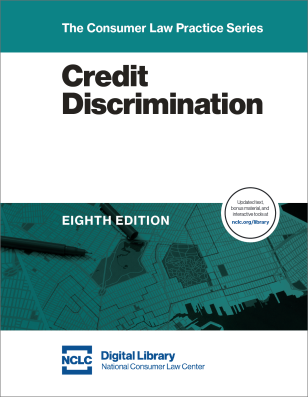This article focuses on the advantages of using credit discrimination laws to challenge predatory and unfair lending and related practices. Reverse redlining claims under the Equal Credit Opportunity Act (ECOA), Fair Housing Act (FHA), and 42 U.S.C. §§ 1981 and 1982 (federal Civil Rights Acts) are potent, but underutilized tools to rectify marketplace misconduct.
On October 22, 2021, the Department of Justice, in conjunction with the Consumer Financial Protection Bureau and the Office of the Comptroller of the Currency, announced a new initiative to investigate and prosecute redlining, including digital redlining, where credit is not offered to certain groups or communities. Just as important is consideration of reverse redlining, where groups or communities are targeted for predatory practices.
Reverse Redlining Applies to Predatory Credit Extensions, Collections, and Sales
Credit discrimination law does not just prohibit discrimination in the denial of credit, but discrimination in targeting communities of color or other protected groups for predatory or unfair credit practices. There need not even be a showing that individuals outside the protected groups are treated more favorably. It is the targeting of protected groups for unfair practices that is the basis for the discrimination. See NCLC’s Credit Discrimination § 8.5.
The Civil Rights Act §§ 1981 and 1982 prohibit discrimination based on race or ethnicity and § 1981 also prohibits discrimination based on citizenship status. The discrimination need not even involve credit, but, for example, the cash sale of goods or services, such as insurance. See NCLC’s Credit Discrimination § 3.6. The ECOA and FHA both prohibit discrimination based on race, color, religion, creed, political affiliation, national origin, immigration status, sex, or sexual orientation. See NCLC’s Credit Discrimination § 3.3. The ECOA also prohibits discrimination based on marital status, age, public assistance status, or good faith exercise of rights under the federal Consumer Credit Protection Act (that includes the FDCPA, TILA, FCRA, ECOA and other statutes). See NCLC’s Credit Discrimination § 3.4. The FHA also prohibits discrimination based on familial status or disability. See NCLC’s Credit Discrimination § 3.5.
Targeting individuals for unfair terms based on any of these characteristics can form the basis of a reverse redlining claim. An ECOA reverse redlining claim must involve some aspect of a credit transaction; an FHA reverse redlining claim must include a housing component; a federal Civil Rights Act reverse redlining claim need not involve either credit or housing, but, for example, can involve cash sales.
Examples of Reverse Redlining Claims
In a recent case, a Michigan class action included FHA and ECOA claims against various entities that targeted Black communities by offering residents abusive leases with an option to purchase recently foreclosed, substandard housing. See Henderson v. Vision Property Management, L.L.P., 2021 WL 3772882 (E.D. Mich. Aug. 23, 2021) (denying motion to dismiss). The case did not allege that the defendants offered home sales at superior terms to other communities—only that Black communities were targeted for predatory practices. A similar case against Harbour Portfolio, raising a reverse redlining claim under the FHA and ECOA based on a contract for deed scheme, also survived a motion to dismiss. Horne v. Harbour Portfolio VI, L.P., 304 F. Supp. 3d 1332 (N.D. Ga. 2018).
Two other cases, City of Oakland v. Wells Fargo & Co., 972 F.3d 1112 (9th Cir. 2020) and Prince George's Cty. v. Wells Fargo & Co., 397 F. Supp. 3d 752 (D. Md. 2019) have survived motions to dismiss based upon FHA claims that Wells Fargo targeted minority communities with equity stripping schemes and abusive servicing and foreclosure practices. A similar class action resulted in a favorable New York jury verdict, but a new trial was ordered on damages. See Saint-Jean v. Emigrant Mortg. Co., 337 F. Supp. 3d 186 (E.D.N.Y. 2018). Other reverse redlining cases are cited at NCLC’s Credit Discrimination § 8.5.1.
Twelve Reasons to Utilize Reverse Redlining Claims to Challenge Predatory Practices
1. Punitive Damages. FHA and federal Civil Rights Act claims allow for punitive damages with no statutory cap. Such recoveries may be easier to obtain and have fewer restrictions than pursuant to a common law fraud claim. See NCLC’s Credit Discrimination § 11.8.4.2. ECOA claims also can lead to punitive damages, but with a $10,000 cap in individual cases and $500,000 or 1% of net worth in class cases. NCLC’s Credit Discrimination § 11.8.4.3.
2. Federal Court Jurisdiction (only if you want it). Most other claims challenging predatory and unfair marketplace practices do not provide for federal jurisdiction, but involve state law claims, such as UDAP and usury statutes and common law fraud claims. RICO is an exception, but it is a complex statute with numerous required elements, including enterprise injury and a pattern of mail or wire fraud, or charging more than twice the enforceable interest rate. The Truth in Lending Act, the Fair Credit Reporting Act, the Fair Debt Collection Practices Act and other federal consumer statutes may not apply to the specific predatory conduct in the case. CAFA may not provide federal jurisdiction for class actions where the conduct is confined to one state.
On the other hand, if one wants to stay out of federal court, reverse redlining claims may still be available under state discrimination laws, patterned after the ECOA, FHA, or the federal Civil Rights Acts. A state-by-state summary of state credit discrimination statutes is found at NCLC’s Credit Discrimination Appendix F. Some state public accommodations statutes—including at least those in Massachusetts—may also give rise to reverse redlining claims, and places of public accommodation are defined broadly in some states to include even online businesses.
3. Attorney Fees. The ECOA, FHA, and federal Civil Rights statutes all provide for attorney fees for a prevailing consumer—a rare combination of both punitive damages and attorney fees. Attorney fees are not available under common law fraud claims or most state usury claims. Not even all UDAP statutes provide for attorney fees. Christiansburg Garment Co. v. Equal Employment Opportunity Commission, 434 U.S. 412 (1978), is Supreme Court precedent where —unlike, for example, the Florida UDAP statute—a losing consumer should only be liable for a defendant’s attorney fees when the plaintiff’s claim was frivolous, unreasonable, or without foundation.
4. Intangible Damages. Under each of the federal discrimination statutes, courts allow sizeable actual damages for intangible losses, such as emotional distress, pain and suffering, humiliation, or damage to credit rating. One reason for allowing such damages is the strong public policy against discrimination. Such public policy is based not only on the economic injury caused by discrimination, but also on the damage that discrimination causes to an individual’s sense of worth, damage to civil rights, and damage to the very fabric of our society. NCLC’s Credit Discrimination § 11.8.2.3.
5. Equitable Relief. The ECOA and FHA explicitly provide for equitable relief, and such relief has been found implicit in the federal Civil Rights Acts. Equitable relief includes injunctions, TROs, declaratory relief, restitution, and disgorgement. Equitable relief should be available on a class-wide basis. Attorney fees are available after obtaining any such relief.
6. Class Actions Often Make Sense. In a reverse redlining case, class action allegations are appropriate because the very nature of the claim—a lender is targeting a particular group or neighborhood. All borrowers in the targeted group or neighborhood who receive loans from the lender are subjected to the same unfair or predatory terms because consumer lenders tend to have standardized credit products. Class-wide targeting is a distinct possibility in any case in which the plaintiff is a member of a protected class and has been subjected to predatory lending. If a practitioner looks for such targeting, it will often be found. Nevertheless, as with any class action, complexities can arise. For example, while a hallmark of credit discrimination cases is the availability to recover intangible damages, highly individual damages are difficult to recover on a class basis. Injunctive relief (like reforming a contract) or easily calculable damages are key for class certification. See NCLC’s Credit Discrimination § 8.4.
7. Broad Applicability. Federal credit discrimination statutes are broader in scope than many state UDAP or usury statutes. For example, UDAP statutes in some states do not apply to credit, real estate, debt collection, foreclosures, regulated practices, and the like.
The ECOA applies to all forms of credit transactions, personal property leases, utility service, and sale of goods with a credit component. The ECOA also applies not only to credit origination, but credit servicing, debt collection, repossessions, foreclosures, and any other aspect of a credit transaction. See NCLC’s Credit Discrimination § 2.2.
The FHA applies to credit used to purchase, build, improve, repair, or maintain a dwelling; to the purchase price, availability, or leasing terms of a dwelling; and to insurance practices related to a dwelling. See NCLC’s Credit Discrimination § 2.3. The FHA applies to both credit origination and to servicing and foreclosure practices.
The Civil Rights statutes are even broader and are not limited to credit or housing. 42 U.S.C. § 1981 applies to the ability of any person to make and enforce contracts. 42 U.S.C. § 1982 applies to discrimination related to a person’s ability to inherit, purchase, lease, sell, hold, and convey real and personal property. The Civil Rights statutes though are only actionable based on a disparate treatment approach, not a disparate impact approach. See NCLC’s Credit Discrimination § 2.4.
8. Direct Liability of Parties Other Than Originating Creditor. Federal credit discrimination statutes explicitly apply not just to originating creditors, but to other parties, which is often key to obtaining significant relief. A predatory lender may be thinly capitalized and virtually judgment proof. Ultimately it is their funding source that enables their behavior and that is an important defendant to join.
The ECOA covers those who regularly participate in the decision of whether to extend credit, including setting the terms of credit, thus reaching brokers, credit sellers, assignees, and other third parties. The FHA also explicitly extends liability to arrangers, brokers, and others providing financial assistance related to a covered loan. See Henderson v. Vision Property Management, 2021 WL 3772882 (E.D. Mich. Aug. 23, 2021) (denying primary funder’s motion to dismiss); NCLC’s Credit Discrimination § 11.2. The FHA also can apply to assignees, and those selling and appraising real estate. The federal Civil Rights Acts have no limit on who can be liable for their violation.
9. No Federal Preemption. National banks claim that national bank federal regulation preempts the applicability of many state laws to the banks’ practices. FDIC-insured banks and those “renting” the rights of those banks claim the right to export their home state usury caps to credit transactions in other states. These bank defenses are all non-issues when it comes to a consumer’s federal discrimination claims that are not preempted by federal regulation and need not be based on usury caps.
10. Credit Discrimination Claims Need Not Rely on Deceptive Conduct or Violation of Specific Statutory Provisions. Unlike UDAP claims in certain states which require deception, or other statutory claims which require violation of a specific statutory provision, credit discrimination claims focus on any conduct targeting a protected group that is unfair, predatory, abusive, or oppressive.
11. Courts May Be Receptive to Discrimination Claims. Because of the strong federal policy against discrimination, courts may be receptive to federal and state discrimination claims. For example, when predatory terms are part of a written agreement, some courts believe that the consumer agreed to the terms and that therefore there is no unfairness. But even a court that takes such a caveat emptor approach to claims relating to unconscionability and unfairness may feel differently about conduct that discriminates based on race or membership in another protected class. See NCLC’s Credit Discrimination § 8.2.
12. Federal Credit Discrimination Statutes May Allow a Plaintiff to Avoid Arbitration Requirements. Arbitration provisions are unenforceable if they prevent vindication of federal statutory rights, including vindication of rights under the federal discrimination statutes. Unlike an unconscionability challenge to a requirement that the consumer arbitrate a state claim, the consumer can show an arbitration clause is unenforceable without showing procedural unconscionability. Instead, the consumer should set out the rights provided by a federal discrimination statute and explain why an arbitration provision limits their vindication.
Arbitration provisions limiting punitive damages, intangible damages, or attorney fees for a prevailing consumer also limit the consumer’s ability to vindicate rights under the federal discrimination statutes. An arbitration provision that makes a consumer liable for a prevailing defendant’s attorney fees or liable for unaffordable arbitration costs could prevent vindication of federal rights under federal discrimination statutes.
Proving Reverse Redlining
A reverse redlining claim requires a showing that the lender targets protected classes. A plaintiff need not show that the company markets a standard product elsewhere, but only that it markets its predatory product targeting a protected class. As is true in other types of discrimination cases, it can be difficult to show that a business intentionally targets people differently based on a protected basis. Instead, litigants may utilize a disparate impact analysis, showing that a practice has a disparate impact on a protected group.
Since the Supreme Court’s decision in the ICP case, pleading a disparate impact claim requires allegations that show a “robust” causal connection between the neutral practice and the disparity. Tex. Dep’t of Hous. & Cmty. Affairs v. Inclusive Cmtys. Project, Inc., 576 U.S. 519 (2015). This typically requires expert statistical analysis. Nonetheless, it may be easier to ultimately prove that a predatory product had a disparate impact on a protected group than to find sufficient evidence of intentional targeting based on race or another protected group. Depending on the facts available at the pleading stage, it may be prudent to plead a reverse redlining claim based on both intentional targeting and disparate impact, raising these theories in the alternative. See NCLC’s Credit Discrimination §§ 4.2, 4.3.
Intentional targeting can be shown by detailing how the lender markets its loans: where it locates storefronts; where it targets mailings or door-to-door visits; and which websites and media it uses to advertise. For a discussion of discrimination in online marketing, see C. Evans and W. Miller, Federal Reserve Board, From Catalog to Clicks, The Fair Lending Implications of Targeted, Internet Marketing, Consumer Compliance Outlook (2019 Third Issue). Courts find evidence of targeting compelling when advertising and other displays feature consumers of color or celebrities of color, placed in media aimed at people of color, but not in comparable media serving primarily white neighborhoods. See NCLC’s Credit Discrimination § 8.5.2.
Lenders also use third parties to market their loans, such as brokers for mortgage loans and car dealers for automobile loans. It is evidence of targeting if a lender solicits brokers or dealers who operate predominantly in communities of color. Evidence of targeting has also been found when lenders pair borrowers of color with sales personnel of the same racial or ethnic background as the borrower. See NCLC’s Credit Discrimination § 8.5.2.
Discovery of internal company documents and training manuals may be instructive. Ex-employees may be another important source of evidence. That the lender harbors ill will toward a protected class is not a necessary element of targeting. An adequate motivation, for example, can be that the lender perceives that protected classes are especially vulnerable to fraud.
Defendants’ Defenses Based on the Protected Class Being a Higher Credit Risk
An essential element of a reverse redlining case is that the business targets the protected class with a predatory or unfair scheme. Defendants will argue that disadvantageous credit terms or other aspects of the scheme are not unfair but necessary to protect the defendant because of the consumer’s high risk of default.
This defense is weakened where the creditor does not consider a consumer’s risk, such as where the creditor does not engage in underwriting or consider the borrower’s ability to repay. High interest rates or other disadvantageous aspects of a loan, even if justified by risk, cannot be justified where the consumer has no need for the credit—such as where a predatory loan refinances an existing loan at significantly worse terms. High risk also cannot be a defense to a high interest rate where discriminatory mark-up policies are involved—where the eventual lender is willing to loan the consumer at a given interest rate (the buy rate) based on the consumer’s risk, and an auto dealer or credit arranger significantly increases the rate the consumer pays beyond the risk-based buy rate.
Even if a consumer is a higher risk than average, this does not justify predatory terms. Compare terms that consumers with a similar risk profile can obtain elsewhere to show that the predatory terms are far beyond a reasonable risk adjustment.



